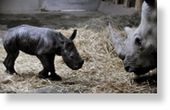
© Bela SzandelszkyThe rhino baby and his mother in the Budapest Zoo
. The rhino baby, a male, was born at 4:57am in the Budapest Zoo on the 22nd of October 2008. In June 2007, scientists from the
Leibniz Institute for Zoo and Wildlife Research in Berlin artificially inseminated his mother, the rhino cow Lulu, with frozen bull semen.
The rhino baby weighed 45 kilos. It is in good health and was accepted by his mom. The birth is "an important success for species conservation and preservation of biodiversity", says Dr. Robert Hermes, one of the IZW-scientists performing the insemination.
The successful outcome is reported in the current online edition of the scientific journal "Theriogenology" entitled "how to fertilise a rhino with cryopreserved semen". For the first time the scientists were able to successfully inseminate a white rhino with cryopreserved semen that was frozen for 3 years at -196 °C in liquid nitrogen.
The 38-years old test tube-father Simba, from the UK, is now a first time father. Scientists turned to this older rhinoceros after two young bachelors at Colchester Zoo were unsuccessful in producing any offspring. To the surprise of the IZW scientists Simba's sperm cells were healthy and highly viable after a fertility examination and were therefore extracted and preserved in liquid nitrogen.
The sperm were frozen with a newly developed deep-freezing technology which is especially suitable for wildlife sperm. The specialists from Berlin used a non-surgical insemination procedure developed at the IZW. This international conservation project was carried out in close co-operation with the
Veterinary University of Vienna.
"This scientific success enables us to bring new gene material from the wild to the rhino conservation breeding without having to transport the animals", tells Hermes. "In the future, reproduction experts can anaesthetise wild bulls, collect semen from them, and use the frozen sperm e.g. for breeding offspring in international zoos. This is a very important result for conservation efforts.
The Northern White Rhino population, in particular, could benefit dramatically from this procedure as there are only three, possibly four individuals left in the wild and only eight individuals in zoos worldwide. Via the establishment of this important method and the patented technology, scientists are hoping to be able to sustain the dwindling populations of these highly endangered species and when needed, fetch them from the "Ice".

Reader Comments
to our Newsletter